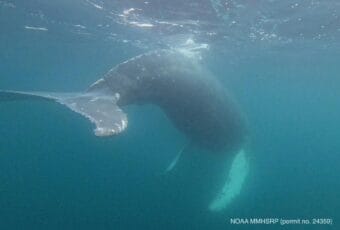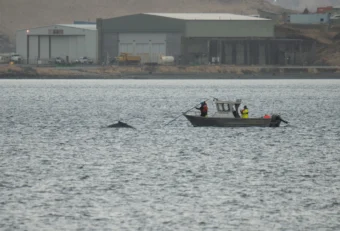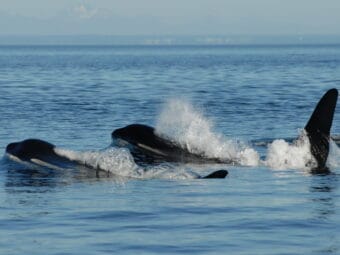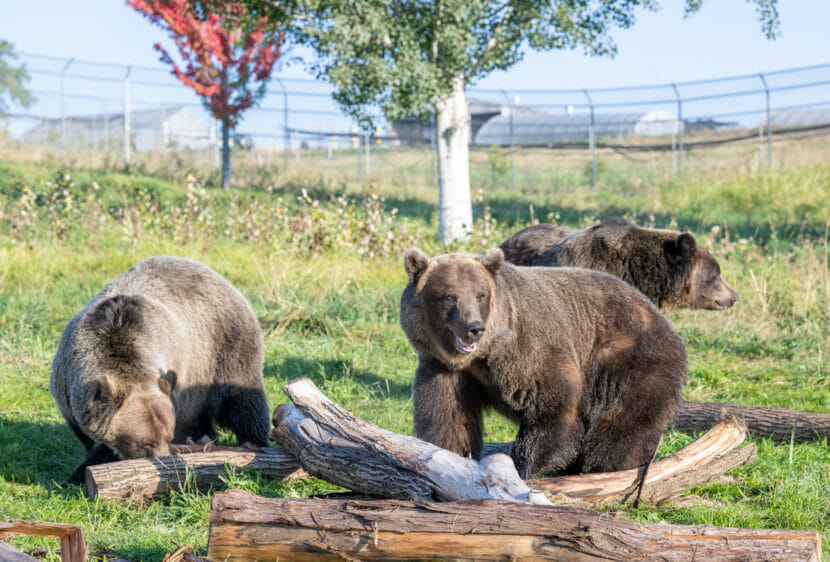
Bears like the heavyweight contenders in Katmai National Park’s Fat Bear Week competition are clearly eating plenty of salmon.
But bears are likely eating more berries than you would think. That’s according to research published in the journal Scientific Reports last month that says bears of all kinds need a more mixed diet.
The study is the work of biologist Charles Robbins, a bear nutrition expert at Washington State University’s Bear Center, which is the only research institution in the U.S. with a captive brown bear population.
It was an observation in the wilds of Alaska, though, that got Robbins thinking maybe bears aren’t as carnivorous as we thought.
Listen:
The following transcript has been lightly edited for clarity.
Charles Robbins: We know that salmon are just a wonderful resource, and so we were watching streams that were a kilometer long and just pool after pool after pool of salmon and just maybe six, seven inches of water, so easily catchable. And what we saw were bears that would come in and eat, certainly, they would come in and eat salmon. But we just hypothesized that they would eat salmon, go to shore, sleep it off, come in, eat more salmon and just do 24 hours of that. But what we saw was that, after they fed up on salmon, they would go off into the surrounding, usually uplands, and eat berries. And the berries were small, dispersed, widely spread out. And they’d spend six to 10 hours a day eating berries and being in those berry fields. And it just didn’t make any sense for us. So at that stage, we came back to WSU where we could work with our captive bears and set up experiments to help us understand it. We assumed at that stage that the bears certainly knew what they were doing, so it was up to us to be able to gain insight into understanding how they viewed these two food resources.
Casey Grove: That’s right, you have a population of captive grizzly bears there. Tell me a little bit about that.
Charles Robbins: Yeah, we started a captive grizzly bear research program 36 years ago now. And it’s the interplay between both captive and wild studies that has yielded so many interesting results and studies. If we’re just studying wild bears, there’s only so much we can understand. If we’re studying captive bears, our understanding is limited by not being able to work with those wild bears. So when we had both of them, then we can learn so much more. They’re only about four blocks from my office. The public has easy access to them, so a fairly open facility.
Casey Grove: With your captive bears there, do you guys have any kind of competitions? Or do you even name them or anything?
Charles Robbins: We name them. The students, if we have some cubs born or bring in a bear from the wild, the students get first crack at naming them, and we just have a vote on kind of the easiest name to remember and say. Other than that, we don’t have really any competitions. We have 11 bears, so we know them as individuals. They have big personalities, they’re fun, they’re challenging. They’re just a wonderful animal to use in our research program. They go by names like Luna and John and Frank. And so it’s easy for us to latch on to one or the other as our favorite bear.
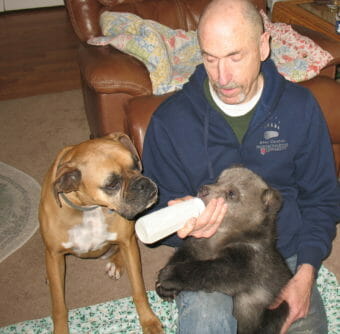
Casey Grove: That was that was gonna be my next question, what are their names?
Charles Robbins: One popular one right now is Adak. He won’t defend the food that we feed him. And so even small females will take his food away. He’s kind of an un-grizzly grizzly bear. So we kind of cheer for him. And hopefully someday he’ll grow up.
Casey Grove: He needs to learn how to protect his food, huh?
Charles Robbins: He does. He needs to learn how to be a grizzly bear.
Casey Grove: So you made this observation, you went back to Washington State University, and you said you started thinking about experiments that would help you get at this question. And how did that go?
Charles Robbins: We have some local hatcheries, so at the time, we were getting significant runs back, and so they were willing to provide the salmon. Obviously, I don’t have enough students on board to go pick huckleberries in the amount that big grizzly bears or brown bears would want to eat. But we have an apple orchard right next door that is very — the apples are very, very similar in terms of being a lot of water, high carbohydrate and not too much else. We started doing studies where we would feed bears, if we’re talking about salmon, all the way from just maintaining their weight up to gaining prodigious amounts, and the same on apples. And then, so the next thing we did was feed both apples and salmon. And we let, in a lot of studies, we let the bears just determine what that mixture would be. And when they mixed them on a daily basis, then they gained more weight per unit of energy intake than either salmon alone or apples alone. And so there was an interaction effect, where by consuming both foods, it actually provided a better diet than either food alone. And that was what we were seeing in the wild bears. So the captive bears, given the choice, would do exactly what we were seeing in the wild bears.
Casey Grove: Interesting, yeah. And is it just about gaining weight or are there other nutritional benefits to eating a more mixed diet?
Charles Robbins: Well, yeah. You can always argue that there’s something in those berries that’s not in the salmon. There is a physiological benefit in that a high-protein diet like salmon, it’s hard on the liver and hard on the kidneys. In other words, all this protein flooding the system, that that protein, the excess nitrogen in the protein gets removed in the liver, converted into urea and then then excreted via the kidneys. That process is energy-demanding, and there’s a lot of ammonia involved. And so it’s, again, hard on those two organs. And so by mixing in carbohydrates and moving the protein content down to a lower level that’s appropriate for an omnivore, there is a feedback mechanism that says that to the bear, that’s a better diet.
Casey Grove: Why were we getting this wrong, I guess, thinking that they just wanted 100% salmon, or at least, you know, a whole lot more salmon?
Charles Robbins: Gosh, that’s a tough one. I suppose just because we see those those bears (at) McNeil River and Katmai Falls and all of those locations. And from a nutrition standpoint, as I said, the salmon are just a wonderful protein, energy, mineral, vitamin source. So there’s no doubt that they’re just a great resource. And so I guess we never looked beyond (that). I’m sure other people saw this relationship where they would see bears feeding on salmon and then disappear. But, you know, until GPS collars came along and more sensitive radio-tracking capability, we probably didn’t look much at the other side of what they were doing, once they, you know, went into those elderberry patches where we couldn’t even see them, or salmon berry patches.
Casey Grove: So then there are implications, I would imagine, for this going forward, whether it’s with captive bears or with bears in the wild. How does this research inform us in in those ways? I mean, what implications are there kind of going forward here?
Charles Robbins: Oh, the easiest direct relationship is with other captive barriers. And we’ve gone on to study, with USGS colleagues, polar bears and how they’re fed in zoos and what they’re eating in the wild. And they’re low-protein, high-fat omnivores. And the directions for taking care of polar bears in zoos has been to use domestic cat nutritional standards. Cats are high-protein, low-fat — in other words, just the opposite of what a polar bear should be fed. And so polar bears die in zoos about 10 years earlier than they should be dying. And the two most prevalent causes are liver cancer and kidney failure. And so we are certainly promoting that zoos change the ways in which they feed these bears. Brown bears are a little bit more adaptable, they’re more capable of handling not the best balance and doing okay, but it’s even nice if we can get them to feed them a better one.

